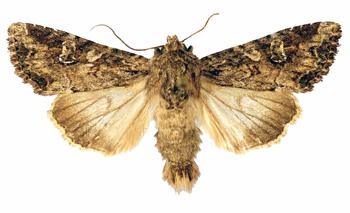Pests
Apamea anceps Den. et Schiff. - Owlet moth.
Systematic position.
Class Insecta, order Lepidoptera, family Noctuidae, genus Apamea.Synonyms.
Hadena sordida Bkh.Biological group.
Cereal pests.Morphology and biology.
Forewings gray, without black longitudinal line, reniform spot with halo-like peripheral border (wingspan 23-32 mm). Hind wings light gray, darker toward external margin. Degree days of 40°C is necessary for imago development. Average fertility 160-950 eggs, maximum to 2000-2500. Eggs are laid in groups, from 3 to 60 and more in an egg-batch (more often 10-25 eggs), on the inner side of spicate and flower scales or in ovary of cereal flowers. Duration of egg development is 8 to 12 days. Caterpillars develop 82 to 92 days depending on temperature, reaching a body length of 30 mm in the last 8th instar. Caterpillars of younger instars feed inside grain; fourth instar-larvae gnaw grains from outside, forming large cavities. On corn, caterpillars damage ears, making large holes. Diapausing caterpillars of older instars over winter in the top layer of soil to a depth of 5-10 cm. They are resistant to cold and can endure one month cooling at a temperature of -10°C. Pupae are red-brown, and on the last segment have 2 long sharp thorns and 4 underdeveloped setae. The pupa phase lasts 20-30 days.Distribution.
Western Europe, Minor Asia, Iran, Mongolia, Baltic States, Byelorussia, Ukraine, Moldova, Transcaucasia, Kazakhstan. In Russia it is distributed in the Volga Basin region, southern areas of Siberia (eastward to Krasnoyarsk), and in the Ural region; northward to Saint Petersburg.Ecology.
One generation develops per year. Moth flight is observed (depending on meteorological conditions) from the middle of June, beginning of July until August. The egg-laying period coincides frequently with anthesis of spring wheat and couch-grass (Elytrigia repens). Moths can fly a long distance. Their fertility depends greatly on temperature and humidity, and also on nectar feeding on flowering weeds (sow-thistle, bittercress, cornflower, sunflower etc.). Grain humidity of at least 20% is necessary for caterpillars to feed; precipitation in August and September favors feeding. Mass reproduction of the pest is promoted by synchronism of egg laying with anthesis of spring wheat. The combination of optimum air temperature (24-25°C) and humidity (70-85%) increases fertility of females. Reproduction is limited by entomophages (predators and parasites) and diseases.Economic significance.
Wheat and barley are the crops most damage by caterpillars. Rye and corn is damaged to a lesser extent, and caterpillars do not damage oat. Control measures include timely and minimal loss harvesting, shelling, and early autumn plowing with a plower that turns the surface of the soil; inter-row treatments of tilled cultures and treating fallows in the first third of June; optimum timing of spring wheat sowing and use of resistant varieties; insecticide treatments against 3rd-4th-instar caterpillars. Pheromone traps are used for pest monitoring.Reference citations:
Azhbenov V.K. 1995. Apamea anceps Schiff. Noctuidae, Lepidoptera in Kazakhstan (biology, ecology, system of forecasts). Summary of Dissertation of Biological Sciences. Almaty. 43 pp. (In Russian)Belyaev I.M. 1974. Pests of grain crops. Moscow: Kolos. 284 pp. (In Russian)
Grichanov I.Y., Azhbenov V.K. 1998. Recommendations on the practical use of pheromone traps for noctuid moth Apamea anceps on summer wheat. St.Petersburg: VIZR. 98-104 pp. (In Russian)
Grigor'eva T.G., Slivkina K.A. 1958. Apamea anceps and its control. Alma-Ata: publisher. 47 pp. (In Russian)
Klyuchko Z.F. 1974. Noctuidae. Harmfulness of Invertebrates and Vertebrates. Kiev: Urozhai. V. 2: 361-408. (In Russian)
Polyakov I.Ya., ed. 1975. Distribution of the main pests of agricultural crops in the USSR and efficiency of their control (Methodical instructions). Leningrad: VASKHNIL, VIZR. 66 pp. (In Russian)
Pospelov S.M. 1989. Noctuidae: Pests of agricultural crops. Moscow: Agropromizdat. 112 pp. (In Russian)
Sukhareva I.L. 1999. Noctuidae: Insects and Ticks-Harmfulness to Agricultural crops. Butterflies. St. Petersburg: Nauka. V. 3(2): 332-378. (In Russian)


